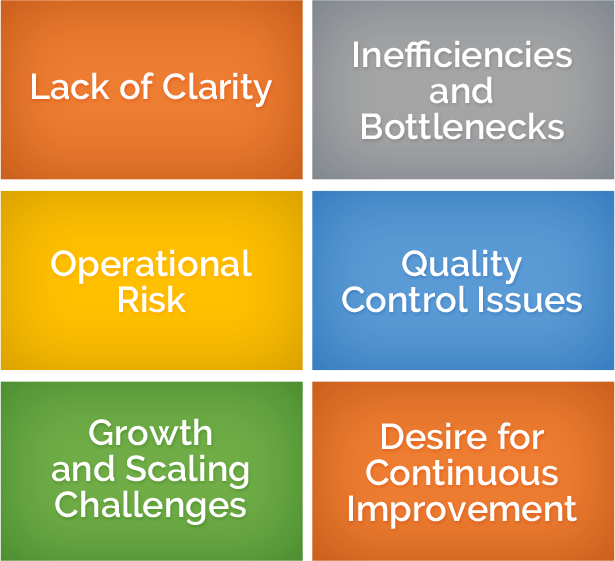Is Business Process Mapping the Right Fit for My Organization's Needs?
Are you considering implementing business process mapping in your organization? It's a good idea to do your research and find out if it's the right fit for your needs, so we’re glad you’re here! By the end of this article, you'll better understand whether Process Mapping may be an effective tool for your organization.
Watch my video on Process Mapping on our Business Consulting page.
Six Ways Process Mapping Can Strengthen Your Business
As outlined in a previous blog post, Process Mapping highlights opportunities for organizational improvement by providing a visual representation of the current state of your processes. It can help to identify redundancies, unnecessary steps, or areas where tasks can be streamlined or automated and help you grow.

Lack of Clarity: If there is confusion or ambiguity surrounding how and by whom certain processes are performed within your company, Process Mapping can bring clarity to role accountability and improve communication through a shared understanding. This can ultimately help you prioritize tasks to larger business goals and improve employee morale.
Inefficiencies and Bottlenecks: If your processes are slow, inefficient, or often delayed, it can waste time and resources and lead to customer dissatisfaction. Process Mapping can help pinpoint the causes of these issues, remove redundancies, streamline your operations, and improve how efficiently tasks are completed.
Operational Risk: If your company is concerned about fraud, regulatory compliance failures, or financial misstatements, process mapping is an essential tool for surfacing these issues. By revealing operational risks, you can put appropriate controls in place to address them, and often improve efficiency at the same time.
Quality Control Issues: If your company has trouble delivering consistent product or service quality, or if you often encounter errors or defects/waste, process mapping can help. By identifying and understanding the root causes, you can put effective quality control measures in place, improving the consistency and quality of your products or services.
Growth and Scaling Challenges: If your organization struggles to grow or absorb that growth, resulting in problems and inefficiencies in your processes, process mapping can help. It allows you to identify areas that need improvement to support your development and make your operations more efficient.
Desire for Continuous Improvement: If your company has a culture of continuous improvement and wants to identify opportunities for optimization, process mapping will guide you through a structured approach to analyzing and improving existing processes.
Recognizing the signs that indicate the need for business process mapping is crucial for improving your company's operations. By identifying these symptoms, you can take proactive steps with the assistance of a consulting team to effectively address your challenges.
What are the benefits and limitations of Process Mapping?
I advocate for Process Mapping because I genuinely believe it is the best long-term fit for most organizations looking to optimize their operations. However, Process Mapping, like any other approach, is not without its limitations. It is essential to understand how you can benefit from this exercise and how to prepare your organization for the effort.
Benefits:
- Increased Clarity Process Mapping provides a visual representation of the workflow, making it easier for employees to understand how tasks are performed and how they fit into the bigger picture. This clarity enhances communication and reduces confusion, leading to improved efficiency and effectiveness in carrying out processes.
- Identification of Inefficiencies: This process allows organizations to identify bottlenecks, redundant steps, and unnecessary delays within a process. By visualizing the entire workflow, it becomes easier to pinpoint areas that can be streamlined or optimized.
- Standardization and Consistency: Process Mapping helps in documenting and standardizing procedures, ensuring that tasks are performed consistently across teams or departments. This consistency reduces errors, improves quality control, and enhances customer satisfaction by delivering a more predictable and reliable experience.
- Enhanced Teamwork and Collaboration: This process fosters collaboration among employees as they gain a shared understanding of the process. It promotes cross-functional cooperation, allowing different teams to align their efforts and coordinate activities more effectively. This collaborative approach leads to improved communication, problem-solving, and innovation within the company.
- Continuous Improvement: Process Mapping serves as a foundation for continuous improvement initiatives. It provides a visual framework for identifying areas of improvement, analyzing process performance, and implementing changes. By regularly reviewing and updating the process map, organizations can drive a culture of continuous improvement, making incremental enhancements to achieve higher levels of excellence over time.
Limitations:
- Time and Resource-Intensive: Process Mapping can be a time-consuming and resource-intensive endeavor. It requires dedicated effort from employees, subject matter experts, and the process mapping team. The process of conducting interviews, gathering information, creating diagrams, and validating accuracy demands significant time and resources.
- Complexity: For highly complex processes, accurately capturing all the intricacies and interdependencies can be challenging. The process map may oversimplify or miss critical details, potentially leading to an incomplete or inaccurate representation of the process.
- Resistance to Change: Employees may resist changes resulting from Process Mapping if they perceive it as disrupting their established routines or questioning their expertise. Overcoming resistance and gaining buy-in from employees can be a challenge, requiring effective change management strategies and clear communication.
- Lack of adaptability: Process maps can become outdated if processes evolve or change rapidly. To ensure their usefulness, regular maintenance and updates are necessary. This ongoing effort requires resources and commitment to keep the process maps current and aligned with the evolving processes.
- Overemphasis on process: Strict adherence to process maps may limit flexibility and adaptability, particularly in dynamic and rapidly changing environments. Companies should strike a balance between following standardized processes and allowing room for creativity, innovation, and agile decision-making.
Will Process Mapping be Effective for My Business?
Let's explore the factors that influence when and how process mapping is most effective at assisting in reaching your business goals and resolving issues.
More Effective:
- Service-Based Companies: Businesses in the service industry, such as financial institutions, healthcare providers, and hospitality companies, can benefit from process mapping. Service delivery often involves multiple steps and interactions, and process mapping can help identify inefficiencies, standardize procedures, and enhance the customer experience.
- Manufacturing and Production Companies: Process Mapping is highly valuable for manufacturing and production companies where operational efficiency is crucial. It enables them to identify waste, reduce errors, optimize workflows, and improve overall productivity. By mapping out the manufacturing process, organizations can streamline production, manage inventory, and ensure quality control.
- Customer-Centric Companies: Companies that prioritize delivering exceptional customer experiences can leverage process mapping to enhance customer satisfaction. By mapping customer touchpoints and interactions, organizations can identify areas for improvement, eliminate pain points, and optimize customer service processes. This enables them to provide a consistent and seamless customer experience.
- Regulatory-Compliant Companies: Companies operating in highly regulated industries such as healthcare, finance, and pharmaceuticals can benefit from process mapping to ensure compliance with industry regulations. Process Mapping helps in documenting procedures, tracking compliance requirements, and demonstrating adherence to regulatory standards.
Less Effective:
- Very Small Businesses: In some cases, very small businesses with minimal processes or a limited number of employees may find the effort and resources required for process mapping to outweigh the benefits. If the operations are straightforward and easily managed without the need for extensive documentation or optimization, Process Mapping may not be a priority.
- Highly Dynamic Industries: Industries that thrive on innovation and constant adaptation, such as design agencies, research and development firms, or artistic endeavors, may have fluid and dynamic processes that are difficult to capture accurately in a traditional process map. In such cases, the emphasis is often on flexibility and agility rather than strict process adherence.
- One-time Projects: Companies that primarily engage in unique, non-repetitive projects or one-off activities may not find long-term benefits from process mapping. If the nature of the business is focused on customized solutions or ad-hoc services, the time and effort invested in process mapping may not provide substantial returns.
- Transitional or Restructuring Organizations: Companies undergoing significant restructuring, mergers, or acquisitions may experience frequent changes in their processes. In such instances, the instability and uncertainty surrounding the processes may make it challenging to create accurate and up-to-date process maps.
How much does Process Mapping cost?
A small Process Mapping project with less complexity and fewer details would require 30-40 hours of our time to complete while larger projects can require upwards of 100 or even 200 hours to complete. The process map output would also include highlighting areas for improvement and direct action you can take to address them.
Ultimately, the decision to implement business process mapping should be based on a thorough evaluation of your organization's unique circumstances and requirements. My team and I specialize in Business Process Consulting and understand the importance of finding the best-fit solution for each organization, even if it means exploring alternative options. Regardless of the approach you choose, we aim to support your business in thriving and achieving its goals.
If you are interested in further exploring process mapping for your company, please feel free to reach out and contact us.
Kate Hermansen, MBA | Director of Business Consulting
Since 2021, Kate has led an experienced team of consultants as the Director of Business Consulting. In this role, she empowers organizations to envision new possibilities, achieve goals faster, and operate with greater efficiency.
Visit our Business Consulting page to learn how our services can transform your organization and propel future growth. Our consulting team is available to discuss your specific needs. Let’s start a conversation.




